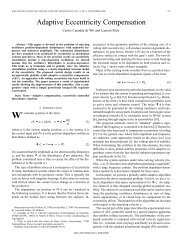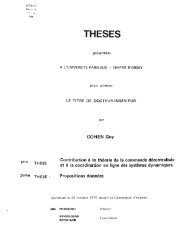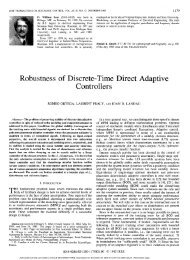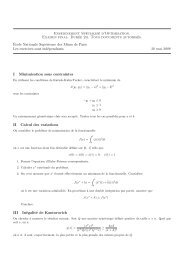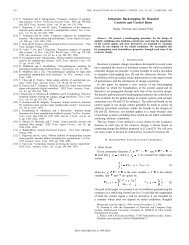HOMOGENEOUS OBSERVER DESIGN 1829bi-limit stabilizing control law for the origin <strong>of</strong> the system (4.1), then there <strong>is</strong> one forthe origin <strong>of</strong> the system with state X i+1 =(X 1,...,X i+1) in R i+1 defined <strong>by</strong>(4.2) Ẋ 1 = X 2,...,Ẋ i+1 = u, i.e., Ẋ i+1 = S i+1 X i+1 + B i+1 u.1Let d 0 and d ∞ be in (−1,n−1) and consider the weights and degrees defined in (3.2).Theorem 4.1 (homogeneous in the bi-limit backstepping). Suppose there ex<strong>is</strong>tsa homogeneous in the bi-limit function φ i : R i → R with associated triples (r 0 , d 0 +r 0,i ,φ i,0 ) and (r ∞ , d ∞ + r ∞,i ,φ i,∞ ) such that the following hold:1. There ex<strong>is</strong>ts α i ≥ 1 such that the function ψ i (X i ) = φ i (X i ) αi <strong>is</strong> C 1 andfor each j in {1,...,i} the function ∂ψi <strong>is</strong> homogeneous in the bi-limit with∂X jweights (r 0,1 ,...,r 0,i ), (r ∞,1 ,...,r ∞,i ), degrees α i (r 0,i + d 0 ) − r 0,j , α i (r ∞,i +d ∞ ) − r ∞,j , and approximating functions ∂ψi0, ∂ψi∞.∂X j ∂X j2. The origin <strong>is</strong> a globally asymptotically stable equilibrium <strong>of</strong> the systems(4.3)Ẋ i = S i X i + B i φ i (X i ) , Ẋ i = S i X i + B i φ i,0 (X i ) , Ẋ i = S i X i + B i φ i,∞ (X i ) .Then there ex<strong>is</strong>ts a homogeneous in the bi-limit function φ i+1 : R i+1 → R withassociated triples (r 0 , d 0 + r 0,i+1 ,φ i+1,0 ) and (r ∞ , d ∞ + r ∞,i+1 ,φ i+1,∞ ) such that thesame properties hold, i.e.,1. there ex<strong>is</strong>ts a real number α i+1 > 1 such that the function ψ i+1 (X i+1 ) =φ i+1 (X i+1 ) αi+1 <strong>is</strong> C 1 and for each j in {1,...,i+1} the function ∂ψi+1<strong>is</strong>∂X jhomogeneous in the bi-limit with weights (r 0,1 ,...,r 0,i+1 ), (r ∞,1 ,...,r ∞,i+1 ),degrees α i+1 (r 0,i+1 + d 0 ) − r 0,j , α i+1 (r ∞,i+1 + d ∞ ) − r ∞,j , and approximatingfunctions ∂ψi+1,0∂X j, ∂ψi+1,∞;∂X j2. the origin <strong>is</strong> a globally asymptotically stable equilibrium <strong>of</strong> the systems(4.4)X i+1 = S i+1 X i+1 + B i+1 φ i+1 (X i+1 ) ,X i+1 = S i+1 X i+1 + B i+1 φ i+1,0 (X i+1 ) ,X i+1 = S i+1 X i+1 + B i+1 φ i+1,∞ (X i+1 ) .Pro<strong>of</strong>. We prove <strong>th<strong>is</strong></strong> result in three steps. First, we construct a homogeneous inthe bi-limit Lyapunov function; then we define a control law parametrized <strong>by</strong> a realnumber k. Finally, we show that there ex<strong>is</strong>ts k such that the time derivative, alongthe trajectories <strong>of</strong> systems (4.4), <strong>of</strong> the Lyapunov function and <strong>of</strong> its approximatingfunctions <strong>is</strong> negative definite.Step 1. Construction <strong>of</strong> the Lyapunov function. Let d V0 and d V∞ be positive realnumbers sat<strong>is</strong>fying(4.5) d V0 > maxj∈{1,...,n} {r 0,j}, d V∞ > maxj∈{1,...,n} {r ∞,j} ,and(4.6)d V∞r ∞,i+1≥ d V 0r 0,i+1> 1+α i .With <strong>th<strong>is</strong></strong> selection, Theorem 2.20 gives the ex<strong>is</strong>tence <strong>of</strong> a C 1 , proper, and positivedefinite function V i : R i → R + such that, for each j in {1,...,n}, the function ∂Vi∂X j<strong>Copyright</strong> © <strong>by</strong> <strong>SIAM</strong>. <strong>Unauthorized</strong> <strong>reproduction</strong> <strong>of</strong> <strong>th<strong>is</strong></strong> <strong>article</strong> <strong>is</strong> prohibited.
1830 V. ANDRIEU, L. PRALY, AND A. ASTOLFI<strong>is</strong> homogeneous in the bi-limit with weights (r 0,1 ,...,r 0,i ), (r ∞,1 ,...,r ∞,i ), degreesd V0 − r 0,j , d V∞ − r ∞,j , and approximating functions ∂Vi,0. Moreover, we havefor all X i ∈ R i \{0},∂X j, ∂Vi,∞∂X j(4.7)∂V i∂X i(X i )[S i X i + B i φ i (X i )] < 0 ,∂V i,0(X i )[S i X i + B i φ i,0 (X i )] < 0 ,∂X i∂V i,∞(X i )[S i X i + B i φ i,∞ (X i )] < 0 .∂X iFollowing [21], consider the Lyapunov function V i+1 : R i+1 → R + defined <strong>by</strong>∫ X i+1(d V0 −r 0,i+1d V0 −r 0,i+1)rV i+1 (X i+1 ) = V i (X i )+ h 0,i+1 r− φ i (X i ) 0,i+1dhφ i(X i)∫ X i+1(d V∞ −r ∞,i+1d V∞ −r ∞,i+1)r+ h ∞,i+1 r− φ i (X i ) ∞,i+1dh .φ i(X i)Th<strong>is</strong> function <strong>is</strong> positive definite and proper. Furthermore, as d V∞ and d V0 sat<strong>is</strong>fy(4.6), we haved V∞ − r ∞,i+1r ∞,i+1≥ d V 0− r 0,i+1r 0,i+1>α i ≥ 1 .Since the function ψ i (X i )=φ i (X i ) αi <strong>is</strong> C 1 , <strong>th<strong>is</strong></strong> inequality yields that the functionV i+1 <strong>is</strong> C 1 . Finally, for each j in {1,...,n}, the function ∂Vi+1<strong>is</strong> homogeneous in∂X jthe bi-limit with associated triples((r 0,1 ,...,r 0,i+1 ),d V0 − r 0,j , ∂V ) (i+1,0, (r ∞,1 ,...,r ∞,i+1 ),d V∞ − r ∞,j , ∂V )i+1,∞.ψ i+1∂X jStep 2. Definition <strong>of</strong> the control law. Recall (1.6) and consider the function: R i+1 → R defined <strong>by</strong>∫ αXii+1 −φi(Xi)α i (ψ i+1 (X i+1 )=−kH |s| αi+1 d 0 +r 0,i+10α i r 0,i+1−1, |s|α i+1d∞+r ∞,i+1where k in R + <strong>is</strong> a design parameter and α i+1 <strong>is</strong> selected as{ }αi r 0,i+1 α i r ∞,i+1α i+1 ≥ max,, 1d 0 + r 0,i+1 d ∞ + r ∞,i+1α i r ∞,i+1.∂X j)−1ds ,ψ i+1 takes values with the same sign as X i+1 − φ i (X i ), <strong>is</strong> C 1 , and, <strong>by</strong> Proposition2.12, <strong>is</strong> homogeneous in the bi-limit. Furthermore, <strong>by</strong> Proposition 2.10, for each jin {1,...,i +1}, the function ∂ψi+1<strong>is</strong> homogeneous in the bi-limit, with weights∂X j(r 0,1 ,...,r 0,i+1 ), (r ∞,1 ,...,r ∞,i+1 ), degrees α i+1 (r 0,i+1 + d 0 ) − r 0,j , α i+1 (r ∞,i+1 +d ∞ ) − r ∞,j , and approximating functions ∂ψi+1,0 ∂ψ,i+1,∞. With <strong>th<strong>is</strong></strong> at hand, we∂X j ∂X jchoose the control law φ i+1 asφ i+1 (X i+1 ) = ψ i+1 (X i+1 ) 1α i+1 .<strong>Copyright</strong> © <strong>by</strong> <strong>SIAM</strong>. <strong>Unauthorized</strong> <strong>reproduction</strong> <strong>of</strong> <strong>th<strong>is</strong></strong> <strong>article</strong> <strong>is</strong> prohibited.
- Page 1 and 2: SIAM J. CONTROL OPTIM.Vol. 47, No.
- Page 3 and 4: 1816 V. ANDRIEU, L. PRALY, AND A. A
- Page 5 and 6: 1818 V. ANDRIEU, L. PRALY, AND A. A
- Page 7 and 8: 1820 V. ANDRIEU, L. PRALY, AND A. A
- Page 9 and 10: 1822 V. ANDRIEU, L. PRALY, AND A. A
- Page 11 and 12: 1824 V. ANDRIEU, L. PRALY, AND A. A
- Page 13 and 14: 1826 V. ANDRIEU, L. PRALY, AND A. A
- Page 15: 1828 V. ANDRIEU, L. PRALY, AND A. A
- Page 19 and 20: 1832 V. ANDRIEU, L. PRALY, AND A. A
- Page 21 and 22: 1834 V. ANDRIEU, L. PRALY, AND A. A
- Page 23 and 24: 1836 V. ANDRIEU, L. PRALY, AND A. A
- Page 25 and 26: 1838 V. ANDRIEU, L. PRALY, AND A. A
- Page 27 and 28: 1840 V. ANDRIEU, L. PRALY, AND A. A
- Page 29 and 30: 1842 V. ANDRIEU, L. PRALY, AND A. A
- Page 31 and 32: 1844 V. ANDRIEU, L. PRALY, AND A. A
- Page 33 and 34: 1846 V. ANDRIEU, L. PRALY, AND A. A
- Page 35 and 36: 1848 V. ANDRIEU, L. PRALY, AND A. A
- Page 37: 1850 V. ANDRIEU, L. PRALY, AND A. A




